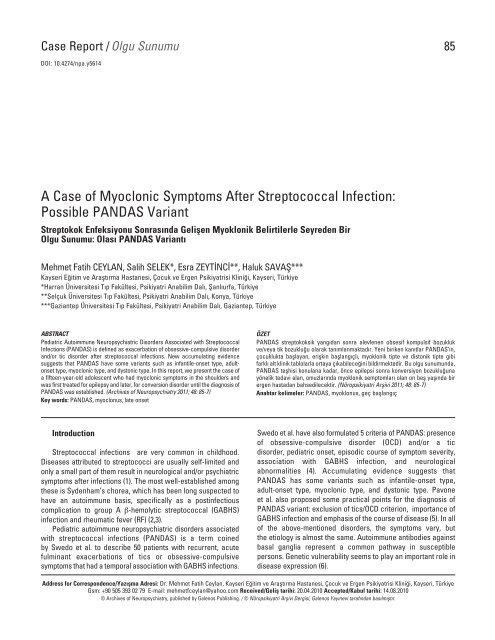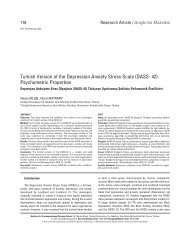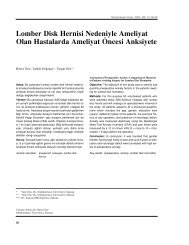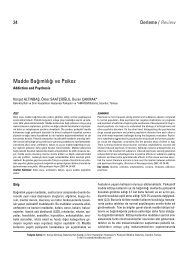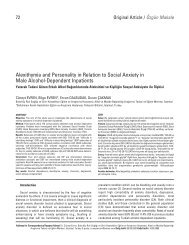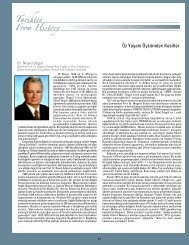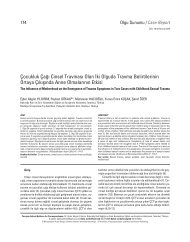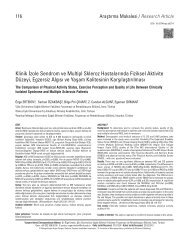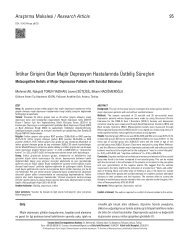A Case of Myoclonic Symptoms After Streptococcal Infection
A Case of Myoclonic Symptoms After Streptococcal Infection
A Case of Myoclonic Symptoms After Streptococcal Infection
Create successful ePaper yourself
Turn your PDF publications into a flip-book with our unique Google optimized e-Paper software.
<strong>Case</strong> Report /Olgu Sunumu 85<br />
DOI: 10.4274/npa.y5614<br />
A <strong>Case</strong> <strong>of</strong> <strong>Myoclonic</strong> <strong>Symptoms</strong> <strong>After</strong> <strong>Streptococcal</strong> <strong>Infection</strong>:<br />
Possible PANDAS Variant<br />
Streptokok Enfeksiyonu Sonras›nda Geliflen Myoklonik Belirtilerle Seyreden Bir<br />
Olgu Sunumu: Olas› PANDAS Variant›<br />
Mehmet Fatih CEYLAN, Salih SELEK*, Esra ZEYT‹NC‹**, Haluk SAVAfi***<br />
Kayseri E¤itim ve Araflt›rma Hastanesi, Çocuk ve Ergen Psikiyatrisi Klini¤i, Kayseri, Türkiye<br />
*Harran Üniversitesi T›p Fakültesi, Psikiyatri Anabilim Dal›, fianl›urfa, Türkiye<br />
**Selçuk Üniversitesi T›p Fakültesi, Psikiyatri Anabilim Dal›, Konya, Türkiye<br />
***Gaziantep Üniversitesi T›p Fakültesi, Psikiyatri Anabilim Dal›, Gaziantep, Türkiye<br />
ABSTRACT<br />
Pediatric Autoimmune Neuropsychiatric Disorders Associated with <strong>Streptococcal</strong><br />
<strong>Infection</strong>s (PANDAS) is defined as exacerbation <strong>of</strong> obsessive-compulsive disorder<br />
and/or tic disorder after streptococcal infections. New accumulating evidence<br />
suggests that PANDAS have some variants such as infantile-onset type, adultonset<br />
type, myoclonic type, and dystonic type. In this report, we present the case <strong>of</strong><br />
a fifteen-year-old adolescent who had myoclonic symptoms in the shoulders and<br />
was first treated for epilepsy and later, for conversion disorder until the diagnosis <strong>of</strong><br />
PANDAS was established. (Archives <strong>of</strong> Neuropsychiatry 2011; 48: 85-7)<br />
Key words: PANDAS, myoclonus, late onset<br />
Introduction<br />
<strong>Streptococcal</strong> infections are very common in childhood.<br />
Diseases attributed to streptococci are usually self-limited and<br />
only a small part <strong>of</strong> them result in neurological and/or psychiatric<br />
symptoms after infections (1). The most well-established among<br />
these is Sydenham’s chorea, which has been long suspected to<br />
have an autoimmune basis, specifically as a postinfectious<br />
complication to group A β-hemolytic streptococcal (GABHS)<br />
infection and rheumatic fever (RF) (2,3).<br />
Pediatric autoimmune neuropsychiatric disorders associated<br />
with streptococcal infections (PANDAS) is a term coined<br />
by Swedo et al. to describe 50 patients with recurrent, acute<br />
fulminant exacerbations <strong>of</strong> tics or obsessive-compulsive<br />
symptoms that had a temporal association with GABHS infections.<br />
ÖZET<br />
PANDAS streptokoksik yang›dan sonra alevlenen obsesif kompulsif bozukluk<br />
ve/veya tik bozuklu¤u olarak tan›mlanmaktad›r. Yeni biriken kan›tlar PANDAS’›n,<br />
çocuklukta bafllayan, eriflkin bafllang›çl›, myoklonik tipte ve distonik tipte gibi<br />
farkl› alt klinik tablolarla ortaya ç›kabilece¤ini bildirmektedir. Bu olgu sunumunda,<br />
PANDAS teflhisi konulana kadar, önce epilepsi sonra konversiyon bozuklu¤una<br />
yönelik tedavi alan, omuzlar›nda myoklonik semptomlar› olan on befl yafl›nda bir<br />
ergen hastadan bahsedilecektir. (Nöropsikiyatri Arflivi 2011; 48: 85-7)<br />
Anahtar kelimeler: PANDAS, myoklonus, geç bafllang›ç<br />
Swedo et al. have also formulated 5 criteria <strong>of</strong> PANDAS: presence<br />
<strong>of</strong> obsessive-compulsive disorder (OCD) and/or a tic<br />
disorder, pediatric onset, episodic course <strong>of</strong> symptom severity,<br />
association with GABHS infection, and neurological<br />
abnormalities (4). Accumulating evidence suggests that<br />
PANDAS has some variants such as infantile-onset type,<br />
adult-onset type, myoclonic type, and dystonic type. Pavone<br />
et al. also proposed some practical points for the diagnosis <strong>of</strong><br />
PANDAS variant: exclusion <strong>of</strong> tics/OCD criterion, importance <strong>of</strong><br />
GABHS infection and emphasis <strong>of</strong> the course <strong>of</strong> disease (5). In all<br />
<strong>of</strong> the above-mentioned disorders, the symptoms vary, but<br />
the etiology is almost the same. Autoimmune antibodies against<br />
basal ganglia represent a common pathway in susceptible<br />
persons. Genetic vulnerability seems to play an important role in<br />
disease expression (6).<br />
Address for Correspondence/Yaz›flma Adresi: Dr. Mehmet Fatih Ceylan, Kayseri E¤itim ve Araflt›rma Hastanesi, Çocuk ve Ergen Psikiyatrisi Klini¤i, Kayseri, Türkiye<br />
Gsm: +90 505 393 02 79 E-mail: mehmetfceylan@yahoo.com Received/Gelifl tarihi: 20.04.2010 Accepted/Kabul tarihi: 14.08.2010<br />
© Archives <strong>of</strong> Neuropsychiatry, published by Galenos Publishing. / © Nöropsikiyatri Arflivi Dergisi, Galenos Yay›nevi taraf›ndan bas›lm›flt›r.
86<br />
In this report, we present the case <strong>of</strong> a fifteen-year-old<br />
adolescent who had myoclonic symptoms in the shoulders<br />
and was initially treated for epilepsy and later, for conversion<br />
disorder until the diagnosis <strong>of</strong> PANDAS was established.<br />
<strong>Case</strong><br />
Ceylan et al.<br />
A <strong>Case</strong> <strong>of</strong> <strong>Myoclonic</strong> <strong>Symptoms</strong> <strong>After</strong> <strong>Streptococcal</strong> <strong>Infection</strong>: Possible PANDAS Variant<br />
A fifteen-year-old male had been evaluated at the<br />
emergency department with complaints <strong>of</strong> nausea and involuntary<br />
movements <strong>of</strong> the shoulders a week after oropharyngeal infection<br />
and high temperature. These symptoms had been considered<br />
relevant to a diagnosis <strong>of</strong> encephalitis or an epileptic disorder.<br />
Because the cerebrospinal fluid (CSF) findings had been<br />
completely normal, encephalitis had been ruled out. Cranial MRI<br />
and Electroencephalographic (EEG) assessment were without<br />
any abnormalities. <strong>After</strong> initiating diazepam infusion, the<br />
symptom <strong>of</strong> myoclonus had been controlled, hence, the patient<br />
had been administered valproic acid at a dose <strong>of</strong> 500 mg per day<br />
for the diagnosis <strong>of</strong> myoclonic epilepsy and had been discharged<br />
after the disappearance <strong>of</strong> myoclonic seizures. Five days later,<br />
the myoclonus had reappeared, so the dose <strong>of</strong> valproic acid had<br />
been increased to 1000 mg per day, but with no response. In<br />
spite <strong>of</strong> adding clonazepam 2 mg/day to the existing<br />
pharmachotherapy, the myoclonus had persisted and showed<br />
periodic pattern.<br />
The patient was admitted to our outpatient clinic six months<br />
after the onset <strong>of</strong> symptoms. Because there was no enough<br />
response to antiepileptic treatment and sometimes the<br />
symptoms were exacerbated by stressor factors, we requested<br />
a consultation by the neurology department regarding the<br />
possibility <strong>of</strong> conversion disorder. The last EEG assessment was<br />
completely normal and the patient was prescribed sertraline 50<br />
mg per day for the diagnosis <strong>of</strong> conversion disorder. The patient<br />
has been followed up at the neurology and psychiatry<br />
departments for ten months exhibiting the same symptom<br />
severity.<br />
At the final evaluation, it was found out that the symptoms<br />
initiated after a high temperature and oropharyngeal infection<br />
and also continued in an episodic pattern. Additionally, it was<br />
understood that myoclonic symptoms followed skin lesions<br />
determined to be pyogenic lesions. Skin swabs were taken for<br />
culture by a dermatologist and were positive for streptococcal<br />
infections, while the throat culture was negative.<br />
Therefore, PANDAS myoclonic type has been suspected<br />
and determination <strong>of</strong> Antistreptolysin-O (ASO) titer was<br />
recommended. Because <strong>of</strong> the fact that the value <strong>of</strong> ASO was<br />
high (345 IU/ml), all psychiatric and neurological treatments<br />
were stopped and intramuscular (IM) penicillin treatment was<br />
suggested for five days. Moreover, considering the probability <strong>of</strong><br />
acute RF, the rheumatology department was consulted, but this<br />
diagnosis was not confirmed due to absence <strong>of</strong> other symptoms<br />
<strong>of</strong> RF.<br />
The myoclonus <strong>of</strong> the shoulders resolved completely with<br />
penicillin therapy. Two months later, ASO titer was measured<br />
again and was as high as the prior one. Thereupon, it was<br />
decided that continuing penicillin prophylaxis (1.200.000 IU /<br />
once every three weeks) was needed.<br />
During the six-month follow-up period, the patient had no<br />
complaints and continued his life in a healthy manner.<br />
Discussion<br />
Archives <strong>of</strong> Neuropsychiatry 2011; 48: 85-7<br />
Nöropsikiyatri Arflivi 2011; 48: 85-7<br />
In this report, we note that it is hard to recognize the<br />
myoclonic variant <strong>of</strong> PANDAS in late-onset cases. According to<br />
the diagnostic criteria <strong>of</strong> PANDAS, the symptom onset must<br />
be between 3 years <strong>of</strong> age and puberty (7). The case presented<br />
here does not meet the PANDAS criteria, but as there are cases<br />
with even later onset, described as adult-onset variant <strong>of</strong><br />
PANDAS, we suggest that late onset can not be an exceptional<br />
feature (8). Additionally, the sudden onset must be taken into<br />
consideration as a supporting detail.<br />
In the literature, there are few reports involving no tics and<br />
obsessive-compulsive symptoms, but only myoclonus (9,10).<br />
Pavone et al. noted that existence <strong>of</strong> OCD/tic disorders may not<br />
be essential in PNADAS variant cases (5). The most common<br />
autoimmune neuropsychiatric disorders associated with<br />
streptococcal infections include Tourette’s syndrome,<br />
Sydenham’s chorea, classic PANDAS and PANDAS variants (5).<br />
In all these disorders, the symptoms vary, but the etiology is<br />
almost the same. In each, it is hypothesized that antibodies<br />
produced as part <strong>of</strong> an immune response to GABHS surface<br />
proteins have antigenic similarities to central nervous system<br />
proteins (molecular mimicry) in susceptible persons. Genetic<br />
and familial factors may also play a role in the pathogenesis <strong>of</strong><br />
PANDAS. It has been found in RF that certain families have a<br />
higher incidence <strong>of</strong> a monoclonal antibody, D8/17. Similarly,<br />
patients with PANDAS have been shown to have similar<br />
elevations <strong>of</strong> D8/17 (4).<br />
The major clinical manifestations include tics and obsessivecompulsive<br />
symptoms in PANDAS. This type <strong>of</strong> neuropsychiatric<br />
symptoms is also observed in Sydenham’s chorea, which is the<br />
only recognized neurological manifestation <strong>of</strong> RF. It is seen in<br />
about 20% <strong>of</strong> patients with acute RF and most <strong>of</strong>ten occurs<br />
weeks to months after group A streptococcal infection (11).<br />
PANDAS patients do not present with classic choreiform<br />
movements or other symptoms <strong>of</strong> RF, but only with tics and/or<br />
obsessive-compulsive symptoms (12). Therefore, a detailed<br />
anamnesis and exploration are necessary and caution should be<br />
applied not to miss a RF.<br />
Our case does not represent a classical PANDAS/PANDAS<br />
variant case, but it is obvious that the myoclonic symptoms<br />
were associated with streptococcal infection. Therefore, our<br />
case points out the need for re-evaluation <strong>of</strong> PANDAS variant<br />
criteria in the future.<br />
Treatments including penicillin prophylaxis, intravenous<br />
immunoglobulin, plasma exchange, tonsillectomy are useful in<br />
this spectrum (1,13). Similarly, our case did not respond to<br />
antiepileptic and antidepressant treatment, but responded to<br />
penicillin.
Archives <strong>of</strong> Neuropsychiatry 2011; 48: 85-7<br />
Nöropsikiyatri Arflivi 2011; 48: 85-7<br />
It was observed that the first oropharyngeal infection and the<br />
following pyogenic skin lesions were associated with the<br />
myoclonic symptoms. It is known that PANDAS is related to<br />
oropharyngeal infection by streptococci, but we also suggest<br />
that streptococcus-associated skin lesions also may induce<br />
PANDAS signs.<br />
References<br />
1. De Oliveira SK. PANDAS: a new disease? J Pediatr (Rio J). 2007; 83:201-8.<br />
[Abstract]<br />
2. Marques-Dias MJ, Mercadante MT, Tucker D et al. Sydenham’s chorea.<br />
Psychiatr Clin North Am 1997; 20:809-20. [Abstract]<br />
3. Cardoso F. Chorea: Non-genetic causes. Curr Opin Neurol 2004; 17:433-6.<br />
[Abstract]<br />
4. Swedo SE, Leonard HL, Garvey M et al. Pediatric autoimmune neuropsychiatric<br />
disorders associated with streptococcal infections: clinical<br />
description <strong>of</strong> the first 50 cases. Am J Psychiatry 1998; 155:264-71.<br />
[Abstract] / [Full Text]<br />
5. Pavone P, Parano E, Rizzo R et al. Autoimmune neuropsychiatric disorders<br />
associated with streptococcal infection: Sydenham chorea, PAN-<br />
DAS, and PANDAS variants. J Child Neurol 2006; 21:727-36. [Abstract] /<br />
[Full Text]<br />
Ceylan et al.<br />
A <strong>Case</strong> <strong>of</strong> <strong>Myoclonic</strong> <strong>Symptoms</strong> <strong>After</strong> <strong>Streptococcal</strong> <strong>Infection</strong>: Possible PANDAS Variant<br />
87<br />
6. van Toorn R, Weyers HH, Schoeman JF. Distinguishing PANDAS from<br />
Sydenham’s chorea: <strong>Case</strong> report and review <strong>of</strong> the literature. Eur J Paediatr<br />
Neurol 2004; 8:21-6. [Abstract] / [Full Text] / [PDF]<br />
7. Leonard HL, Swedo SE. Paediatric autoimmune neuropsychiatric disorders<br />
associated with streptococcal infection (PANDAS). Int J Neuropsychopharmacol<br />
2001; 4:191-8. [Abstract]<br />
8. Bodner SM, Morshed SA, Peterson BS. The question <strong>of</strong> PANDAS in<br />
adults. Biol Psychiatry 2001; 49:807-10. [Abstract] / [Full Text] / [PDF]<br />
9. Di Fazio MP, Morales J, Davis R. Acute myoclonus secondary to group<br />
A beta-hemolytic streptococcus infection: A PANDAS variant. J Child<br />
Neurol 1998; 13:516-8. [Abstract] / [PDF]<br />
10. Smyth P, Sinclair DB. Multifocal myoclonus following group A streptococcal<br />
infection. J Child Neurol 2003; 18:434-6. [Abstract] / [PDF]<br />
11. Giedd JN, Rapoport JL, Kruesi MJ et al. Sydenham’s chorea. MRI <strong>of</strong> the<br />
basal ganglia. Neurology 1995; 45:2199-202. [Abstract]<br />
12. Swedo SE, Leonard HL, Mittleman BB et al. Identification <strong>of</strong> children<br />
with pediatric autoimmune neuropsychiatric disorders associated with<br />
streptococcal infections by a marker associated with rheumatic fever.<br />
Am J Psychiatry 1997; 154:110-2. [Abstract] / [PDF]<br />
13. Murphy ML, Pichichero ME. Prospective identification and treatment <strong>of</strong><br />
children with pediatric autoimmune neuropsychiatric disorder associated<br />
with group a streptococcal infection (PANDAS), Arch. Pediatr. Adolesc.<br />
Med. 2002; 156:356-61. [Abstract] / [PDF]


